Currently Empty: ₹0.00
Drama & Theatre
Chhattisgarh Theatre: Tradition and Modern Fusion

Chhattisgarh Theatre
Being a rich state with tribal culture and natural beauty, the theatre culture here is very different. Therefore, the theatre of Chhattisgarh represents an amalgamation of tribal customs, folklore, and rituals of Chhattisgarh—an amalgamation of ancient forms held together by contemporary narratives. As the theatre traditions emanate, life-like portrayals of the people ensue through stories interwoven around nature, spirituality, and social issues. The theatre in Chhattisgarh is presented, therefore not for entertainment, but social integration and sustenance of culture.
This blog is going to deal with forms of traditional theatre in Chhattisgarh, their folk and tribal roots, and the modern time’s theatre development to get a peek at the dynamic art that it is through the key players of this art.
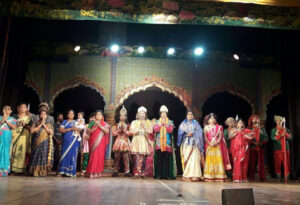
Historical Perspective of Theatre Movement in Chhattisgarh
Drama in Chhattisgarh is an affair that runs deep in history—since tribals did rites and congregated with each other. For centuries, the tribal groups of the region—the Gonds, Baigas, and Halbas—have used performance as a medium to tell about their relationship with nature, their gods, and each other. The performances would be held during festivals, harvesting, and other major events, which were further an extension of their religious and social practices.
As the state grew, the theatre of Chhattisgarh continued growing, with traditional forms developing into modern concepts. While one pole continued with folk theatre, modern theatre came up in cities and painted socio-economic-political reality in the region.
Traditional folk and tribal theatres of Chhattisgarh:
Chhattisgarh owes much to its folk and tribal traditions of performing arts, which are normally performed in open spaces and community settings. They seem to be integrally connected with the daily lives of these people, using a lot of music and dance, inviting audience participation and improvisation.
- Nacha: The Soul of Chhattisgarh’s Folk Theatre
Nacha has grown as one of the most salient and loved forms of Chhattisgarh folk theatres. The category of theatre carries full energy and amusement with song, dance, and storytelling all blended. It originally comes from the rural parts of Chhattisgarh and is said to be one of the amusement sources for the people since long, as it still is in the cultural life of this region.
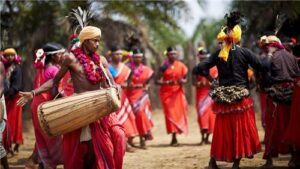
Key Features of Nacha
Music-Centric Performances: Nacha is immensely energetic in its musical and dance performances. The performance consists of traditional instruments: dhol, mandar, and bansuri or flute accompany the performance to set the festive mood.
Themes of Humor and Satire: Nacha in general has a play with comic and satirical stories that critically analyze social norms, politics, and human behaviors. Comically, the performers will talk of serious issues over poverty, caste discrimination, and corruption; hence, keeping the audience engaged between laughter and messages to take back home.
Improvisation and Audience Participation: Nacha is an improvisation among all the typical features. The performers are always in interaction with their audience, making light-hearted, random jokes, and changing the whole scenario of their performance according to how the crowd would react. This interactive feature keeps the shows fresh and participatory.
Renowned Artists: The legendary folk artist Teejan Bai, who was well-versed in Pandavani, also performed Nacha. She brought into Nacha the elements of Pandavani in energy and vigor. Other renowned exponents of Nacha are Faguram Yadav, who with comic sense, dramatized the day-to-day problems of the people.
- Pandavani: The Epic Storytelling Tradition
Pandavani, another important form of folk theatre from Chhattisgarh, is characterized by presentations all based on the stories taken from the epic Mahabharata. In the folk theatrical presentation, one extraordinary story is told through his expressions with drama and joined by a few musical performers who narrate episodes of the Mahabharata.
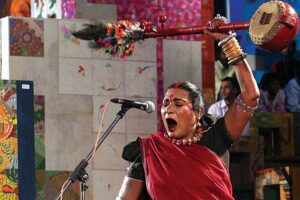
Main Features of Pandavani:
Solo performances generally are the traditional signature of Pandavani, wherein one enacting storyteller presents characters from the Mahabharata. The performer takes very few props along with him; more often than not, only a tambura stringed instrument and a piece of cloth are on the stage. One depends upon voice modulation, facial expressions, and gestural drama to continue with the story.
Music and rhythm in rhythmic beats are given to the text through musical instruments like the manjira and the dholak. Among them, the tambura plays a strong role both as an important musical instrument and as a prop, which at times assumes the role of a bow or a sword in the hands of the narrator.
Thematic Focus: Basically, Pandavani has been about the heroic acts that Bhima or other Pandava brothers were involved with. Tales are often full of bravery, justice, and morality, relating to social and cultural sentiments that find recognition amongst the audiences.
Teejan Bai: By and large, the most well-known face representing Pandavani is Teejan Bai. She has popularized this form of narration all over the world. Her powerful voice and energetic performance style, along with a deep understanding of the Mahabharata, have achieved critical acclaim, including the Padma Vibhushan. Teejan Bai has performed powerfully across India and the rest of the world, thereby popularizing Pandavani as a global cultural mascot from Chhattisgarh.
- Gammat: The Theatrical Folk Comedy
Well, at heart, Gammat embodies social and political satire except for the usual theatre format of Chhattisgarh which emanates humor and childlike playfulness. It finds its way through in order to entertain the audience while subtly criticizing a certain few of the many societal predicaments.
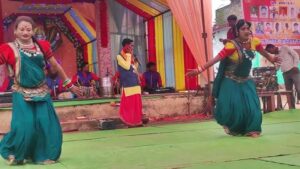
Key features for Gammat:
Humor and satire: Gammat is a comic theater where, by relying on wit and slaps and puns, players keep the audience entertained. Most of the plays often burlesque politicians and local leaders, social customs, and so makes Gammat an important tool for social commentary.
Improvisation: it is only that Nacha improvises much, while Gammat does likewise. Oftentimes, the interaction with the spectators resorts to funny jokes and includes at-the-moment things to say, according to their reaction.
Community participation: The gammat, according to the rule, is performed during festivals and community functions; it therefore represents a major chunk of social bonding in rural Chhattisgarh. This encompasses the audience in its fold, creating an excellent atmosphere for interaction and healthy participation.
- Raut Nacha: The Dance-Drama of the Yadav Community
Raut Nacha is the typical dance-drama form of Yadav or cowherds of Chhattisgarh, especially performed during Diwali times. In this, the performance of the heroic deeds of Lord Krishna especially as a protector of cows and cattle are enacted.
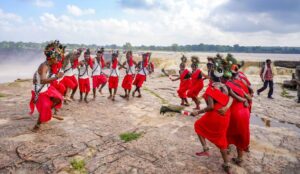
Key features of Raut Nacha:
Mythological themes: Raut Nacha narrates the stories of Lord Krishna and the cowherders that surround him. It comprises several themes such as devotion, valor, and pastoral life. Performances reflect a high concern for the rural agrarian way of life of the Yadav people.
It was a mixture of some kind of dance and drama, whereby the participants performed the various episodes in Krishna’s life. Mandar and dholak provided tempo and liveliness to the dance, along with other traditional instruments.
Cultural Significance: Raut Nacha is not just entertainment; it is actually a ritual performance that celebrates the cycle of agriculture and how much cattle means in village life. This represents the attachment of the people of Chhattisgarh to their land.
Modern Theatre in Chhattisgarh
Probably, folk and tribal theatres are especially related to Chhattisgarh. However, gradually, with the passage of time, modern theatre, too, assumed a concrete shape in this region more so in the urban centers like Raipur and Bilaspur. It encompasses contemporary social issues even while drawing from the traditional types.
- Theatre Groups and Organizations Coming into Being
The theatre groups and organizations in Chhattisgarh have contributed significantly to the modern theatre movement, of which probably the most outstanding amongst them is the Chhattisgarh Lok Kala Manch, which intelligently combines folk theatre with contemporary subjects. It has played a very important role in holding on to conventional forms like Nacha and Pandavani while at the same time experimenting with modern themes related to poverty, caste discrimination, and environmental issues.
Another such society is Raipur Natya Sangh, which has continuously worked for theater promotion in Chhattisgarh since its inception. Raipur Natya Sangh has arranged festivals, workshops, and theatrical performances; it’s another ensemble acting as a platform for performing local artists.
- Themes in the Modern Theatre The modern theatre, therefore, in Chhattisgarh very often tackles some burning social and political issues, reflecting the changed reality in the region. Certain key themes are discussed as under:
Tribal Identity and Land Rights: Most contemporary plays pertain to the struggle of the tribal people in Chhattisgarh, especially vis-à-vis land rights, displacement, and environmental degradation. These plays are a medium and a platform whereby the voices of tribals are raised and brought to light, pointing out the problems indigenous peoples of the land face amidst industrialization and urbanization. Castes and Social Hierarchy: Today, the theater in Chhattisgarh speaks of issues related to caste discrimination and social hierarchy in the lives, of the most deprived communities and their struggle for justice and honor. Political Corruption may be the case of the plays in the modern Chhattisgarh theatre, which deals with political corruption and exploitation of poor people. The resources made satire on failure in governance and the impact of corruption on rural and tribal communities. 3. Theatre Festivals and Workshops Significance The festivals of theatre and workshops are also important to the development of modern theater in Chhattisgarh. The annual Raipur Theatre Festival invites theater groups throughout the state and outside to present performances that reflect the cultural diversities of the region. Theatre groups and cultural institutions alike arrange workshops for imparting training and fostering fresh talent amongst actors, directors, and playwrights of the next generation in Chhattisgarh. Chhattisgarh theatre is always standing at an evolving phase, and it garners its strong roots from the tribals and folk of that state. Starting from Nacha and epic enactments of Pandavani to comic satire in Gammat and the ritualistic dance-drama of Raut Nacha, Chhattisgarh’s theatre reflects a rich cultural variety of its geographical boundaries. What also continues to emerge is the modern theatre of Chhattisgarh, vocal on the contemporary social and political issues of the world over, even while retaining the traditional forms of the state. Thus, Chhattisgarh theatre functions as a bridge between what once was and what is now a site for creative expression and social commentary. Keeping alive the various forms of traditional folk performances apart from new-age plays, theatre in Chhattisgarh will not grow less as an integral component of the cultural life of this state.




